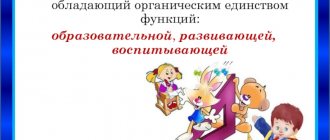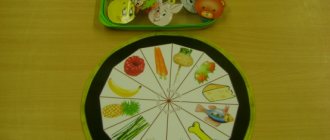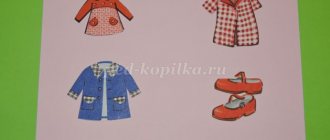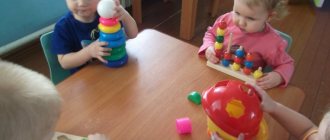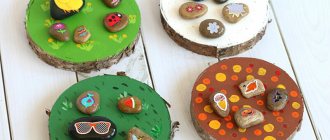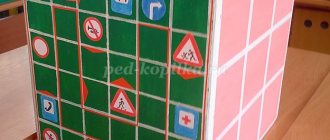Progress of the game:
1 option
(determining the place of sound in a word) (Appendix 1)
The teacher shows the children a funny train and 9 pictures, explains: “The funny train goes to Sound City. He will bring gifts for the sound [A]. In the first carriage you can load gifts in the name of which the sound [A] is heard at the beginning of the word (corresponding diagrams are placed on the roofs of the carriages), in the second carriage - gifts in the name of which the sound [A] is heard in the middle of the word, and in the third carriage - gifts in the name of which the sound [A] is heard last.” The game can be played by 1 child (if working individually), three children (each selects pictures for their own carriage), 9 people (each child takes only 1 picture and looks for a suitable carriage), 12 children (9 people arrange the pictures in the carriages, and 3 children - controllers, check whether all the pictures are in their correct places).
Option 2
t (determining the number of syllables in a word)
The game is played in the same way as option 1, only the game task changes: it is necessary to select pictures with a given number of syllables (one-syllable words in the first carriage, one-syllable words in the second, 2-syllable words in the third, 3-syllables in the third).
Option 3
(sound analysis of the word)
Children are asked to select pictures that match the corresponding sound pattern of the word, and then distribute them among the cars.
Option 4
(selection of words with a given sound, automation and differentiation of given sounds)
This option is more appropriate to use with 1 child, or with several children whose general group of sounds is impaired. Picture material is selected individually.
Option 5
(improving the lexical and grammatical structure of speech) (Appendix 2)
By changing the task cards on the roofs of the cars, the teacher can offer the children:
Choose words-attributes for the pictures traveling in the carriage (pajamas: flannel, yellow, warm, soft);
Choose words - actions (frog: croaks, jumps, catches);
Name one object and many (bucket - buckets);
Name five such objects (hoop - five hoops);
Play “Greedy” and name objects using the words “my”, “mine”, “mine”, “mine” (my shampoo, my glasses, my pajamas);
Play “Hide and Seek” - name what is not in the carriage (no cup, hoop, bucket);
Name objects affectionately (doll, Christmas tree, pillow);
Answer the questions: “Whose ears? Whose tail? (fox ears, fox tail);
Name the mother, father and baby animals traveling in the carriage (mom is a chicken, dad is a rooster, baby (chick) is a chicken).
Picture material is selected specifically for each task. If necessary, teachers can expand the range of tasks, for example, use cards with preposition diagrams to compose sentences, and so on.
Suevalova O.V., teacher-speech therapist
The game “Merry Little Train” is designed for children of senior preschool age with speech disorders. Can be used by speech therapists and educators for individual, subgroup and frontal work. The practical significance and novelty of the game lies in its variability, in the ability to solve a wide range of problems using just one manual.
Didactic math game for preschoolers 3-6 years old
Didactic game for preschoolers “Mathematical Engine”
Author: Natalya Evgenievna Khokhlova Position: teacher-defectologist, MKDOU No. 18 (branch), Miass, Chelyabinsk region Name of resource: didactic game “Mathematical Engine” Brief description of the resource: game for preschool children on formation of elementary mathematical concepts, development of logical thinking. The purpose and objectives of the resource: strengthening counting skills, number composition, number series, ordinal counting; development of visual perception, logical thinking. Relevance and significance of the resource: the game can be used by speech therapists, defectologists, and parents in correctional work with children. Equipment: the game is made using a PC (personal computer), consists of planar images: a steam locomotive, trailers, wheels for trailers. Practical application: individual lessons, frontal correction lessons (as a demonstration of a task or a direct game “one at a time”). Method of working with the resource: 1. Individually: the child takes one of the trains.
A number is depicted on the wheel of the locomotive, the child places a trailer next to it and matches the wheels with numbers or dots to the trailer so that in pairs they make up the indicated number. 2. Front: used to demonstrate a task using a magnetic board and magnets; Children in their seats work orally and frontally. This game is aimed at strengthening counting skills and number composition. Option I
Place a train with several carriages in front of the child (the number of carriages depends on the child’s mastery of counting limits) and offer to number the carriages in order. For numbering, you can use any cards with numbers or use wheels from trailers.
For example, a train within 3
Then invite the child to count the total number of trailers, or count them in order, thus strengthening the ordinal count. Or, as an option to reinforce ordinal counting, invite your child to line up the trains with the numbers depicted on them in order.
Option II
Offer your child one of the trains with a certain number. Ask to prepare it for a long trip. But for this he needs to attach trailers. We don't know how many there will be. Therefore, we begin to attach one trailer at a time and select wheels for the trailer so that a pair of wheels together makes up the number depicted on the train. Carriages:
Wheels:
You can use wheels with dots or numbers. For example, the following trains can turn out:
You can invite your child to count how many trailers the locomotive will carry. Come up with other tasks using this material. I wish you creative success!
We recommend watching:
Passport for the senior group math corner Mathematical game in kindergarten for preschoolers with learning difficulties Do-it-yourself didactic game for preschoolers 4-6 years old according to FEMP Mathematical games for preschoolers 3-5 years old in kindergarten
Similar articles:
Math tasks in pictures for children 6-7 years old
Exercises with counting sticks for preschoolers
Teaching mathematics using the Nikitin method
Math problems jokes for preschoolers
Mathematical riddles for preschoolers in verse with answers
Relaxation task “The bee interferes with sleep”
Pinocchio. Imagine, guys, that you are little bear cubs. You are resting, and a small bee flies into your den. She wanted to sit on someone’s tongue, but the cubs quickly clenched their teeth, made their lips into a tube and began to twist them in different directions (show). The bee was offended and flew away. The cubs again slightly opened their mouths, their tongues are resting. Mama bear came and turned on the light. Because of the bright light, the cubs closed their eyes tightly and wrinkled their noses (show). Mom sees: everything is in order, she turned off the light. The cubs stopped squinting and wrinkling their noses. The bee has arrived again. The cubs did not chase it away, but rolled it on their foreheads, moving their eyebrows up and down. The bee thanked the cubs for the pleasure and flew off to bed.
Educator. It's time for us to go back to kindergarten. Thank you, Pinocchio, for an interesting story game.
Pinocchio. Thank you for taking me on such an interesting adventure. Can I come to you again?
Game task “Unspell the picture.”
There are numbers hidden in the picture, you need to find them and name them, answer in which images the numbers are hidden. The children name the numbers, and the teacher puts them on a flannelgraph so that the children do not repeat themselves.
- Well done, guys, you very quickly found all the numbers and spelled the picture. Everyone was very attentive and we can hit the road. There's a knock on the door, Buratino comes in.
- Hello, guys, I was in such a hurry, I was afraid to be late. I know that today you are going on a journey to the land of Mathematics “Please take me too, I also want to learn a lot, I promise to be attentive and obedient.”
- Guys, let's take Pinocchio with us. Let's teach him everything we know ourselves.
We will travel on a fabulous train, but we need to assemble it.
Task “Make a train”.
The teacher displays 6 trailers, the children count. Each carriage has a conductor. How many conductors? What more? Less? Equally, for how much? But then another guide came running (exhibits). What more now? How many are there? How many more are there than carriages? So 7 is more than 6 by 1.
Introducing the number 7.
What does it look like? Let's draw her.
Here is the seven-poker, She has one leg.
Now let's draw it in the air.
- Well done boys. We have assembled the train, now we need to choose the route we will take.
Task “Choosing a route.”
— Guys, we have two roads, one is red, the other is green. (Children have stripes drawn on sheets of paper, 10 cm and 5 cm long, so that the children do not compare using the application method. This path is shorter along that one and we will go. How to find out? How to do this? (Suggest to compare the paths by length using a rectangle. Show me how to do this. One rectangle fits on the red carpet, and two on the green carpet. So which track will we take? Correct. Now become a little train and hit the road.
- Pinocchio, can I be a train, and the children be carriages? Go! Music sounds, the “train” travels through the group.
- So we arrived at the first station. An interesting game awaits us here.
Task “Find your house”
Numbers from 1 to 7 are placed in different places in the group. These are house numbers. Children have cards with number shapes. Children must find their house.
Well done guys, now it's time to move on. We have arrived at the station of geometric figures.
Task “Where is my trailer.”
Geometric figures are also planning to travel by train; there are many geometric figures standing at the stop. When the train approached, all the figures quickly scattered to their carriages. “How did they recognize their carriage? Children do the task at their desks. Each one has four trailers drawn on cardboard with outlines of geometric shapes, sets of geometric shapes.
- Well done, guys, everything is correct. Now let's move on.
We arrived at the next station. An interesting task awaits us here.
Assignment: “When does this happen?” Each child has a model of the day,
- What parts of the day do you know? Show this on your models.
- Now be very careful to answer my questions correctly,
When do children go to kindergarten? When do we have lunch? When do they turn on the lights in the room? When does the moon shine? (Pinocchio answers together with the children; he is wrong; the children correct him.).
Pinocchio. Wow, how much I learned today. I'm tired, and you guys? Let's sit on the grass and relax a little.
